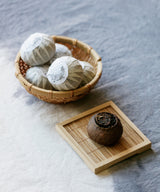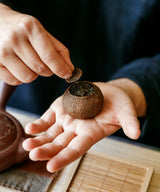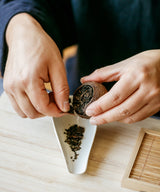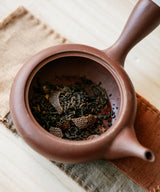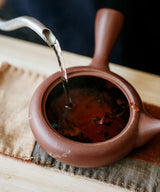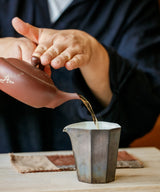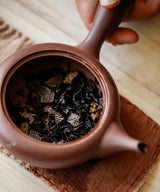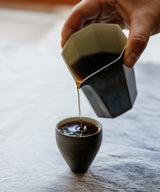Imperial Pu'erh in Red Mandarin 2010
天马红柑宫廷熟普洱2010
Harvest
Spring 2010
Origin
Menghai, Yunnan
This is a notorious tea. The Lange Tea Factory, where it comes from, has been making red mandarin pu’erh since the 1970’s, and has a reputation for doing it more rigorously and to greater results than anywhere else in the world.
They source red mandarin peel from Tianma, the most prestigious village for producing chen pi (orange peel). For this tea, fruit was selected from the oldest trees with peels that are thick and full-bodied.
The imperial pu’erh ripe that fills the hollowed mandarins is from Menghai, Yunnan. The trees are 70 years old, and as imperial grade, only the tips are selected to make this pu’erh. The tea was crafted using traditional methods, and sun-dried, rather than pan-fried over charcoal, to finish for clarity of flavour.
The tea and the orange have been aging together, one densely packed inside the other, for 13 years. This is a remarkably long time compared to most versions of this tea available on the market! At this point, the pu’erh ripe and aged orange peel have become one thing – fully integrated, into a third-entity all its own.
Looking at them together, contained by the dried orange, the entire thing looks cast in bronze - we can see the perfect dimples of the orange rind, frozen in time. As we have mentioned in regards to other teas where aged orange peel is used, this fruit must be aged for at least 6 years before being combined with tea to be sure all moisture is gone from it. Aged this long, dried orange peel is considered a medicinal substance on its own, and carries many benefits to the body. The flavour also becomes full and concentrated over time. The peel in this tea is now 19 years old; we smell its depth prominently in the gaiwan, alongside the sweet earthy smell of the pu’erh ripe.
Broken into, and broken apart, this tea brews a clear, bronze, sunset-tinted liquor. The taste is very clean and direct, with a weight and softness that feels hydrating. Considering the age of the ingredients, its purity is quite remarkable. The full essence of the orange peel comes out in second and third infusions: its sweet, oily flavour envelopes the taste of the tea, delivering it like a parcel - just as it looks.
The clean and lifted taste of this tea make us thing that this is a pu’erh for people who don’t normally drink pu’erh – Still, like all pu’erhs we love, it offers some wisdom; in this case on containers and contents, Time, and the perfect marriage of two things.
. . .
Brewing guide
| Tea | 4 g |
| Temperature |
100°C |
| Water | 120 ml |
| Steep time | 10 - 60 sec |
| No. of infusions | 10 |


